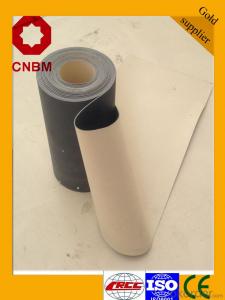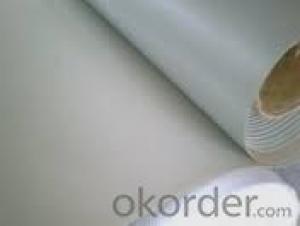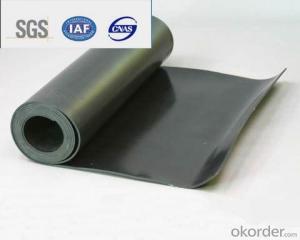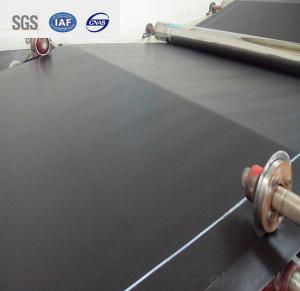Elastomer(SBS)Modified Bitumen Waterproofing Membrane
- Loading Port:
- China main port
- Payment Terms:
- TT OR LC
- Min Order Qty:
- 10 m²
- Supply Capability:
- 800000 m²/month
- Option:
- 1m*10m
OKorder Service Pledge
OKorder Financial Service
You Might Also Like
Item specifice
01 Product introduction Product Introduction
Jiuyang Elastomer (SBS) modified asphalt waterproof coil adopts thermoplastic elastomer (styrene-butadiene-styrene) modified asphalt as dipping coating material. With high quality polyester felt as the base, both sides coated with elastomer asphalt coating, with fine sand, mineral particles (sheets), PE film, aluminum film and other coating materials, the elastomer modified asphalt waterproof sheet is refined by advanced technology. The product has good waterproof performance and anti-aging performance. It has the characteristics of no flowing at high temperature, no brittle cracking at low temperature, simple construction and no pollution.
02 Product characteristics
1. Strong impermeability.
2. High tensile strength, large elongation, good dimensional stability and strong adaptability to base shrinkage deformation and cracking.
3. Good high and low temperature resistance, suitable for building waterproof in low temperature environment.
4. Puncture resistance, crack resistance, tear resistance, corrosion resistance, mildew resistance, weather resistance.
5. Convenient construction, hot melt construction four seasons can be operated, reliable joints.
03 Applicable scope
1. Widely used in roofing, basement, toilet, pool and other waterproof and moisture-proof of industrial and civil buildings, bridge, parking lot, swimming pool, tunnel, reservoir and other buildings, waterproof, moisture-proof, gas insulation, anti-seepage and asphalt roofing maintenance projects.
2. SBS modified asphalt waterproof coil is especially suitable for building waterproofing in cold areas and areas with frequent structural deformation.
04 Packaging and storage andtransportation
1. During transportation and storage, different types and specifications of products should be stored separately and should not be mixed. Avoid sun and rain, pay attention to ventilation.
2. Storage temperature should not be higher than 50℃, vertical storage can only be single layer.
3. Prevent tilt or transverse pressure during transportation, and cover felt cloth if necessary.
4. Under normal transport and storage conditions, the storage period is one year from the date of production.
- Q:Can a waterproofing membrane be used for tunnels and subway stations?
- Yes, a waterproofing membrane can be used for tunnels and subway stations. Waterproofing membranes are designed to prevent the ingress of water and moisture into structures, making them an ideal solution for underground spaces such as tunnels and subway stations that are prone to water infiltration. These membranes are typically made of high-quality materials such as bitumen or synthetic polymers, which have excellent water-resistant properties. Using a waterproofing membrane in tunnels and subway stations provides several benefits. Firstly, it helps to protect the structural integrity of the underground infrastructure by preventing water from seeping into the concrete or other building materials. This can help to prevent corrosion and degradation of the structure, ensuring its longevity and safety. Secondly, a waterproofing membrane helps to maintain a dry and comfortable environment within the tunnels and subway stations. It prevents water from accumulating, which can lead to the growth of mold, mildew, and other harmful microorganisms. Additionally, it helps to control humidity levels, reducing the risk of condensation and water damage to equipment, electrical systems, and other components. Furthermore, waterproofing membranes can also act as a barrier against the ingress of external contaminants such as pollutants, chemicals, and gases. This is particularly important in subway stations, where there may be a higher concentration of pollutants from train exhaust and other sources. Overall, using a waterproofing membrane in tunnels and subway stations is a crucial step in ensuring the durability, safety, and comfort of these underground structures. It provides an effective solution for preventing water infiltration, protecting the infrastructure, and maintaining a dry and healthy environment for passengers and staff.
- Q:Can a waterproofing membrane be used on precast stainless steel surfaces?
- Precast stainless steel surfaces can indeed utilize a waterproofing membrane. Regardless of the substrate material, these membranes are specifically designed to form a protective barrier against water infiltration. To effectively safeguard against moisture and avoid any potential harm or leakage, the membrane can be directly applied to the stainless steel surface. However, it is crucial to carefully choose a suitable waterproofing membrane that demonstrates both compatibility with stainless steel and strong adhesion properties. Furthermore, it is imperative to adhere to proper surface preparation and application techniques in order to maximize the membrane's performance.
- Q:Is the asphalt waterproofing membrane facing the side?
- Because there are many types of self-adhesive waterproofing membrane, their use and construction methods are different, there are two main methods. 1, the normal self-adhesive paving method: the film directly paving or polymer cement cement wetting method, paste in the grass-roots level. The bottom of the floor floor of the building, in the concrete cushion with cement mortar leveling, and then the coiled surface of the membrane down, paste in the leveling layer, the roll surface pouring 50 thick stone concrete protective layer, Floor concrete. Wall construction, the film directly attached to the basement wall panels, and then do the protective layer on the outside. Commonly used modified asphalt self-adhesive waterproofing membrane, modified asphalt wet sheet is usually used in this method.
- Q:How is a waterproofing membrane installed?
- To achieve proper installation and effective waterproofing, the installation process of a waterproofing membrane usually follows a step-by-step approach. Here is a general outline of how the installation takes place: 1. Surface Preparation: The initial step involves preparing the surface where the membrane will be installed. This necessitates a thorough cleaning of the surface, eliminating any dirt, debris, or loose materials. The objective is to create a clean and smooth surface to ensure optimal adhesion of the membrane. 2. Priming: Subsequently, a primer is applied to the surface to enhance the adhesion between the membrane and the substrate. It also provides a uniform surface for the membrane to adhere to. 3. Membrane Application: The next step involves applying the waterproofing membrane onto the prepared surface. There are various types of membranes available, such as sheet membranes or liquid-applied membranes. Sheet membranes are typically rolled out onto the surface and adhered using a suitable adhesive or self-adhesive backing. Liquid-applied membranes are spread or sprayed onto the surface in multiple coats, allowing each coat to cure before applying the next one. 4. Seam and Joint Treatment: In areas where multiple sheets or sections of the membrane intersect, special attention is given to treating the seams and joints to ensure a watertight seal. This may entail overlapping the sheets and applying a seam tape or using a liquid-applied sealant to fill any gaps or joints. 5. Protection and Drainage: Once the membrane is installed, it is crucial to safeguard it from damage and facilitate proper drainage. This can be achieved by installing a protective layer, such as a geotextile fabric or a drainage board, over the membrane. These layers serve to prevent punctures or abrasions and allow any water that penetrates the surface to drain away effectively. 6. Quality Control: After the completion of the installation, it is essential to conduct quality control checks to ensure the correct installation of the membrane. This may involve visual inspections, water tests, or the utilization of specialized equipment to test the integrity of the membrane. It should be noted that the specific installation process may vary depending on the type of waterproofing membrane employed and the requirements of the project. It is advisable to adhere to the manufacturer's guidelines and consult with a professional waterproofing contractor for accurate installation instructions.
- Q:Can a waterproofing membrane be used for dams?
- Yes, a waterproofing membrane can be used for dams. These membranes are designed to prevent water leakage by creating a barrier that is resistant to water penetration. They can be applied to the surface of the dam to ensure its integrity and prevent seepage of water through the structure.
- Q:Can a waterproofing membrane be used in food processing or pharmaceutical facilities?
- Yes, a waterproofing membrane can be used in food processing or pharmaceutical facilities. Waterproofing membranes are designed to provide a protective barrier against moisture, which is beneficial in environments where hygiene and cleanliness are paramount, such as food processing or pharmaceutical facilities. By preventing water penetration, these membranes help maintain a dry, clean, and hygienic environment, ensuring the safety and integrity of the products being processed or manufactured.
- Q:Can a waterproofing membrane be used in areas with high levels of salt or saltwater exposure?
- Yes, a waterproofing membrane can be used in areas with high levels of salt or saltwater exposure. Waterproofing membranes are designed to provide a protective barrier against moisture, including saltwater. They are often used in coastal regions, marine environments, or areas with high salt content in the soil to prevent water damage and corrosion.
- Q:Are waterproofing membranes fire-resistant?
- No, waterproofing membranes are not inherently fire-resistant. However, there are specific types of waterproofing membranes that have fire-resistant properties and can be used in situations where fire protection is required.
- Q:Can a waterproofing membrane be used for swimming pool decks?
- Yes, a waterproofing membrane can be used for swimming pool decks. Waterproofing membranes are designed to provide a barrier against water penetration, making them an effective solution for protecting pool decks from water damage and leaks.
- Q:Can a waterproofing membrane be used on tile surfaces?
- Yes, a waterproofing membrane can be used on tile surfaces. It helps to provide an additional layer of protection against water damage and helps to prevent water penetration through the tile surface and grout lines.
1. Manufacturer Overview |
|
|---|---|
| Location | |
| Year Established | |
| Annual Output Value | |
| Main Markets | |
| Company Certifications | |
2. Manufacturer Certificates |
|
|---|---|
| a) Certification Name | |
| Range | |
| Reference | |
| Validity Period | |
3. Manufacturer Capability |
|
|---|---|
| a)Trade Capacity | |
| Nearest Port | |
| Export Percentage | |
| No.of Employees in Trade Department | |
| Language Spoken: | |
| b)Factory Information | |
| Factory Size: | |
| No. of Production Lines | |
| Contract Manufacturing | |
| Product Price Range | |
Send your message to us
Elastomer(SBS)Modified Bitumen Waterproofing Membrane
- Loading Port:
- China main port
- Payment Terms:
- TT OR LC
- Min Order Qty:
- 10 m²
- Supply Capability:
- 800000 m²/month
- Option:
- 1m*10m
OKorder Service Pledge
OKorder Financial Service
Similar products
New products
Hot products
Hot Searches
Related keywords


























